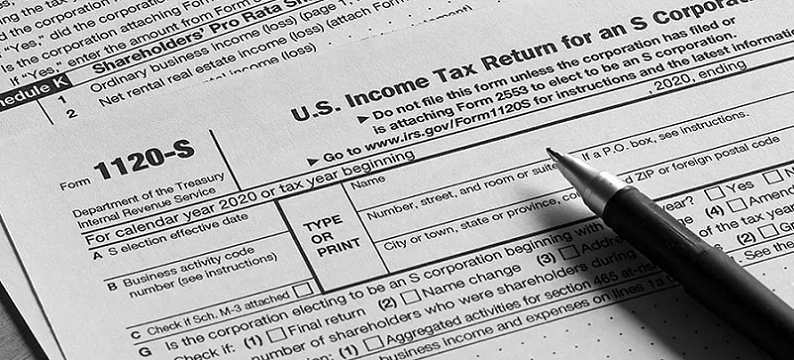
As the year draws to a close, business owners are faced with a critical task – preparing for year-end taxes. For small businesses structured as S-Corporations, this process requires careful consideration and strategic planning to optimize tax outcomes. S-Corporations, known for their tax advantages and flexibility, offer unique opportunities for business owners to minimize their tax liabilities and maximize their profits. However, to harness these benefits, it’s essential to understand the complexities of S-Corporation taxation and implement effective year-end tax planning strategies.
Contents
- Understanding S-Corporation Taxation
- Key Tax Deadlines for S-Corporations
- S-Corporation Income and Expense Review
- Maximizing Deductions for S-Corporations
- Managing S-Corporation Shareholder Compensation
- Utilizing S-Corporation Tax Credits
- Managing S-Corporation Shareholder Distributions
- Considerations for S-Corporation Losses
- References
Understanding S-Corporation Taxation
S-Corporations are a popular choice among small business owners due to their unique taxation structure.
Explanation of S-Corporation Tax Status
S-Corporations are a tax status option available to qualifying small businesses in the United States. What sets them apart from other structures, like C-Corporations or LLCs, is that they are considered “pass-through” entities for tax purposes. This means that the corporation itself does not pay federal income taxes. Instead, profits and losses “pass through” to the individual shareholders, who report them on their personal tax returns. This tax treatment can lead to potential tax savings for S-Corporation owners.
Comparison with Other Business Structures
To fully grasp the significance of S-Corporation taxation, it’s crucial to compare it with other common business structures.
C-Corporations
Unlike S-Corporations, C-Corporations are subject to double taxation. The corporation pays taxes on its profits, and shareholders are also taxed on any dividends they receive. S-Corporations eliminate this double taxation, making them an attractive option for many small businesses.
Limited Liability Companies (LLCs)
While LLCs also offer pass-through taxation, they provide more flexibility in terms of ownership and management. However, S-Corporations have stricter eligibility requirements and may offer better retirement plan options.
Benefits of S-Corporation Taxation
S-Corporations come with several tax-related advantages.
Tax Savings
As mentioned earlier, S-Corporations avoid double taxation, potentially resulting in lower overall tax liabilities for shareholders.
Pass-Through Deductions
Shareholders can claim certain deductions and credits directly on their personal tax returns, which can lead to substantial tax savings.
Flexible Profit Distribution
S-Corporations can allocate profits and losses to shareholders in a way that aligns with their individual tax situations, offering flexibility in tax planning [1].
Avoiding Self-Employment Tax
While shareholders must pay themselves a reasonable salary, they can also receive additional income as distributions, which are not subject to self-employment tax.

Key Tax Deadlines for S-Corporations
Managing tax deadlines is crucial for S-Corporations to avoid penalties and ensure compliance with tax regulations.
Overview of Important Tax Deadlines
S-Corporations must adhere to various tax deadlines throughout the year. Here are some of the most significant ones.
March 15th
This is the deadline for filing S-Corporation tax returns (Form 1120-S) for the previous calendar year. S-Corporations are required to report their income and deductions on this form.
March 15th
Shareholders of S-Corporations receive Schedule K-1 (Form 1120-S), which outlines their share of the corporation’s income, deductions, and credits. Shareholders must report this information on their individual tax returns.
April 15th
Individual shareholders must file their personal income tax returns (Form 1040) and pay any taxes owed. They should include the information from Schedule K-1 in their filings.
September 15th
For S-Corporations that request an extension, this is the deadline for filing an extended tax return (Form 7004). Note that this extension only applies to the corporate return, not the individual shareholder returns.
Consequences of Missing Deadlines
Failing to meet these tax deadlines can have serious consequences for S-Corporations.
Penalties
Late filing of S-Corporation tax returns can result in substantial penalties. The IRS imposes both late filing and late payment penalties, which can quickly add up.
Loss of S-Corporation Status
If an S-Corporation consistently fails to file its tax returns on time, it may risk losing its S-Corporation status, subjecting it to different tax rules and potential double taxation.
Shareholders rely on the information provided in Schedule K-1 to file their own tax returns. Delays in providing this information can inconvenience shareholders and potentially lead to their noncompliance with individual tax deadlines.
How Proper Planning Can Help Meet Deadlines
Effective year-end tax planning involves more than just gathering financial documents at the last minute. To meet tax deadlines efficiently, consider the following.
Maintain Up-to-Date Records
Keep accurate financial records throughout the year to streamline the tax preparation process.
Work with Tax Professionals
Collaborate with tax advisors who are familiar with S-Corporation tax rules. They can help ensure compliance and identify opportunities for tax savings [2].
Plan for Extensions
If necessary, plan for tax extensions well in advance to avoid late filing penalties. However, remember that extensions only apply to the corporate return, not individual shareholder filings.
S-Corporation Income and Expense Review
In the realm of year-end tax planning for S-Corporations, conducting a thorough review of income and expenses is a pivotal step.
Analyzing S-Corporation Income
Discussing Business Income Sources
Start by comprehensively examining the sources of your S-Corporation’s income. This may include revenue from sales, services, investments, or other activities. Understanding where your income originates will help you strategize for the year-end.
S-Corporations typically pass on profits to shareholders in the form of distributions. These distributions can have tax implications, so it’s essential to keep a record of when and how much was distributed to each shareholder.
Identifying Deductible Expenses
Common Business Expenses
Take stock of your business’s expenses for the year. This encompasses everything from rent and utilities to salaries, advertising, and office supplies. Ensure that you have accurate records for all these expenditures.
Identifying Potential Deductions
Beyond the obvious expenses, identify potential deductions that can reduce your taxable income. This may include depreciation on assets, bad debts, research and development expenses, and more. Consult with a tax professional to ensure you’re maximizing these deductions.

Maximizing Deductions for S-Corporations
When it comes to year-end tax planning for S-Corporations, one of the primary objectives is to maximize deductions. By strategically planning your deductions, you can reduce your taxable income and ultimately lower your tax liability.
Strategies for Increasing Deductions
Prepaying Expenses
Consider prepaying certain deductible expenses before the end of the tax year. This can include rent, insurance premiums, and office supplies. By doing so, you can accelerate deductions into the current year and reduce taxable income.
Accelerating Depreciation
If your S-Corporation owns depreciable assets, such as equipment or machinery, review your depreciation schedule. Accelerated depreciation methods like Section 179 and bonus depreciation can allow you to deduct more of the asset’s cost in the current year [3].
Managing Retirement Plan Contributions
S-Corporations can offer retirement plans to their employees, including the owner-shareholders. Contributing to these plans can be a tax-efficient way to reduce taxable income while saving for retirement.
Discussing Limitations on Deductions
Deduction Limitations
Some deductions may be subject to limitations based on your S-Corporation’s income or specific tax regulations. For example, the deduction for business interest expenses may be limited for certain high-income S-Corporations.
Qualified Business Income (QBI) Deduction
Shareholders in S-Corporations may be eligible for the QBI deduction, which allows for a deduction of up to 20% of qualified business income. Understanding the rules and limitations of this deduction is crucial for maximizing its benefits.
Effective management of shareholder compensation is a critical component of year-end tax planning for S-Corporations. How you structure and allocate compensation to shareholders can impact both your business’s financial health and your personal tax liability.
Understanding “Reasonable Compensation”
The IRS expects that shareholder-employees of an S-Corporation receive “reasonable compensation” for their work. Reasonable compensation is the compensation that a shareholder would receive for performing similar services at another company in a comparable role. Failing to pay reasonable compensation can trigger IRS scrutiny.
Factors Influencing Compensation
Consider various factors when determining reasonable compensation, including the industry, geographical location, experience, and responsibilities of the shareholder-employee. Compensation should reflect market norms for similar positions.
Avoiding Excessive Compensation Pitfalls
The Risk of Excessive Compensation
While it’s essential to pay reasonable compensation, paying excessively high salaries to shareholders can lead to unintended tax consequences. The excess can be reclassified as a dividend, subjecting it to income tax.
Dividends vs. Salary
Understanding the tax implications of dividends versus salary is crucial. Salary is subject to payroll taxes, while dividends are not. Striking the right balance between these forms of compensation can optimize your overall tax position [4].
Shareholder loans to the S-Corporation can have tax implications. If not properly structured and documented, these loans can be considered additional income to the shareholder, leading to unexpected tax consequences.
Proper Documentation
To ensure that shareholder loans are not treated as income, maintain clear documentation outlining the terms, interest rates, and repayment schedules. Compliance with these requirements is essential for tax purposes.

Utilizing S-Corporation Tax Credits
When it comes to year-end tax planning for S-Corporations, leveraging available tax credits can significantly reduce your tax liability. Tax credits are powerful tools that directly offset your tax bill.
Overview of Available Tax Credits for S-Corporations
Research and Development (R&D) Tax Credit
This credit rewards S-Corporations that invest in research and development activities. It can be a valuable incentive to encourage innovation.
Work Opportunity Tax Credit (WOTC)
The WOTC provides tax incentives to employers who hire individuals from targeted groups, such as veterans or those receiving government assistance.
Small Business Health Care Tax Credit
S-Corporations that provide health insurance to their employees may be eligible for this credit, which helps offset the cost of providing healthcare coverage.
Qualifications and Requirements for Tax Credits
R&D Tax Credit
To qualify for the R&D tax credit, your S-Corporation must engage in qualified research activities, and the expenses related to these activities must meet specific criteria. Documenting your research activities is essential to claim this credit successfully [5].
WOTC
Eligibility for the WOTC depends on the characteristics of the new hires and the duration of their employment. Detailed records and compliance with the WOTC certification process are necessary to claim this credit.
Small Business Health Care Tax Credit
To claim this credit, your S-Corporation must meet certain requirements, including offering health insurance through the Small Business Health Options Program (SHOP) Marketplace and covering at least 50% of the employee-only premium costs.
Tips for Maximizing Tax Credit Benefits
Stay Informed
Keep up to date with changes in tax laws and regulations related to tax credits. The rules surrounding tax credits can change, so it’s essential to be aware of any updates.
Document Thoroughly
Proper documentation is crucial when claiming tax credits. Maintain detailed records of expenses, activities, and employee qualifications to support your claims.
Consult a Tax Professional
Given the complexity of tax credits and the potential benefits they offer, it’s advisable to consult with a tax professional who can assess your specific situation and help you maximize your tax credit benefits.
Managing shareholder distributions is a vital component of year-end tax planning for S-Corporations. The decisions you make regarding how and when to distribute profits to shareholders can have significant tax implications for both the corporation and its shareholders.
Strategies for Tax-Efficient Distributions
Balance Salary and Distributions
Striking the right balance between shareholder salary and distributions can optimize your tax position. While salaries are subject to payroll taxes, distributions are not, making them an attractive option for reducing tax liabilities.
Evaluate Individual Tax Situations
Consider the individual tax situations of your shareholders when planning distributions. Some shareholders may benefit from more substantial distributions, while others may prefer higher salaries to maximize retirement plan contributions.
Proactive Planning
Plan distributions well in advance of year-end to ensure they align with the financial needs and tax strategies of the shareholders.
Implications of Distribution Timing
Year-End Distributions
Distributing profits to shareholders at year-end can help reduce the S-Corporation’s taxable income. However, ensure that distributions align with the corporation’s financial health and cash flow needs.
Quarterly or Monthly Distributions
Some S-Corporations opt for regular, periodic distributions to shareholders. This approach can provide a more predictable income stream for shareholders but requires careful planning to avoid excessive distributions.
Avoiding Unintentional Dividends
Understanding Dividend Rules
It’s crucial to be aware of the IRS rules surrounding dividends. If distributions are not properly structured, they can be reclassified as dividends, subjecting them to income tax.
Documentation and Compliance
To avoid unintentional dividends, maintain clear documentation of distributions and ensure that they meet the requirements for distributions, not dividends.
Considerations for S-Corporation Losses
Navigating losses is a significant aspect of year-end tax planning for S-Corporations. While no business aims for losses, they can occur, and understanding how to manage them effectively is crucial.
Understanding Losses
S-Corporation losses occur when the corporation’s deductible expenses exceed its income for the tax year. These losses can have implications for both the corporation and its shareholders.
Passive vs. Active Losses
It’s essential to differentiate between passive and active losses. Passive losses are generally losses from activities in which the shareholder does not materially participate, while active losses result from business activities in which the shareholder is actively involved.
Passive Activity Loss Rules
Passive Activity Loss (PAL) Rules
The IRS has specific rules regarding passive activity losses. Passive losses are generally not deductible against non-passive income, such as wages or portfolio income. However, they can offset passive income.
Material Participation
Shareholders who materially participate in the S-Corporation’s activities may be able to deduct passive losses against their other income, subject to certain limitations.
Carryforward and Carryback Options
Carryforward of Losses
S-Corporation losses can typically be carried forward indefinitely to offset future income. This can be advantageous for smoothing out tax liabilities over time.
Carryback of Losses
In certain situations, S-Corporations may be eligible to carry losses back to prior years to obtain refunds for taxes paid in those years. However, carrybacks have specific rules and limitations.
References
[1] Corporate Tax Planning Strategies
[2] Year-End Tax Planning for Individuals and Businesses
[3] Tax Planning Strategies: Tips, Steps, and Resources for Planning
[4] Critical year-end tax planning advice for small business owners
[5] Steps to Take Now to Get a Jump on Your Taxes
